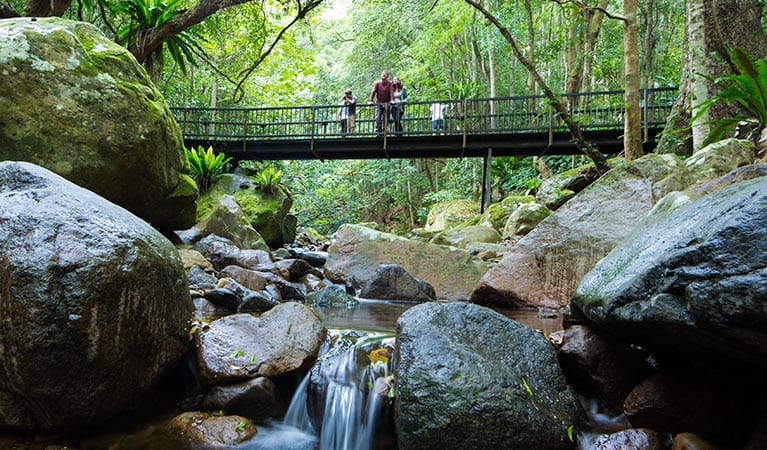School excursion
Earth's natural systems at Minnamurra Rainforest
Budderoo National Park
Overview
Earth's natural systems at Minnamurra Rainforest is a Stage 6, Year 11 school excursion that focuses on geography as a learning area. Students will undertake a geographical investigation focusing on the characteristics and functioning of the natural systems in a rainforest environment.
Read more about Earth's natural systems at Minnamurra Rainforest
This excursion provides an in-depth examination of the value, characteristics and functioning of the rainforest ecosystem at Minnamurra Rainforest, Budderoo National Park.
Undertaking geographic inquiry, students engage in fieldwork and use geographical tools to examine the atmospheric, hydrological, geomorphic and ecological systems that make up the forest. Students will use sampling methodologies, environmental assessment techniques and specialised fieldwork instruments to measure a range of abiotic and biotic conditions.
By comparing and contrasting their results, students will identify key processes, cycles and circulations that affect the functioning of the forest.
Students learn how an understanding of these factors is needed for sustainable management.
The fieldwork techniques used will support students undertaking their Geographical Investigation in natural environments.
For program outline, safety and practical information about this excursion, see info for teachers
| Stage | Stage 6 (Years 11-12) |
|---|---|
| Learning area | Geography |
| Student outcomes |
GE-11-01. Examines places, environments and natural and human phenomena, for their characteristics, spatial patterns, interactions and changes over time GE-11-02. Explains geographical processes and influences, at a range of scales, that form and transform places and environments GE-11-04. Assesses responses and management strategies, at a range of scales, for sustainability GE-11-06. Identifies geographical methods used in geographical inquiry and their relevance in the contemporary world GE-11-07. Applies geographical inquiry skills and tools, including spatial technologies, fieldwork and ethical practices, to investigate places and environments |
| Objectives |
Students will:
|
Excursion details
- When
Weekdays during school terms.
- Availability
- Guided. Available on request. Different length programs are available on consultation.
- Duration
- 2-5 hr
- Grading
- Easy. Fieldwork will take place beside a river along the rainforest path.
- Price
-
Minimum $550 per group for up to 25 students, $22 per student (includes GST).
- Accessibility
- No wheelchair access
- Meeting point
- Minnamurra Rainforest Centre
- Equipment
provided - Yes. Worksheet masters, pre-activity and post-activity resources. Additional references will be provided on booking.
- Booking
- If you would like to organise a NPWS school excursion please get in touch with local staff or use the 'Enquire' link for the online form.
Local alerts
For the latest updates on fires, closures and other alerts in this area, see https://www.nationalparks.nsw.gov.au/education/stage-6-geography-earths-natural-systems-at-minnamurra-rainforest/local-alerts
Operated by
- School excursion inquiries - Minnamurra Rainforest Centre
- 02 4236 0469
- discovery.scr@environment.nsw.gov.au
- Budderoo National Park, Minnamurra Falls Road (Tourist Drive No.9), via Jamberoo NSW 2533
Park info
- in Budderoo National Park in the South Coast and Country NSW regions
Budderoo National Park is always open but may have to close at times due to poor weather or fire danger. The park gates at Minnamurra Rainforest Centre open at 9am and close at 5pm every day.
-
Park entry fees:
$12 per vehicle per day only in the Minnamurra Rainforest area. Bus or taxi: $4.40 per adult and $2.20 per child.
Buy annual pass.
Info for teachers
All the practical information you need to know about Earth's natural systems at Minnamurra Rainforest.

